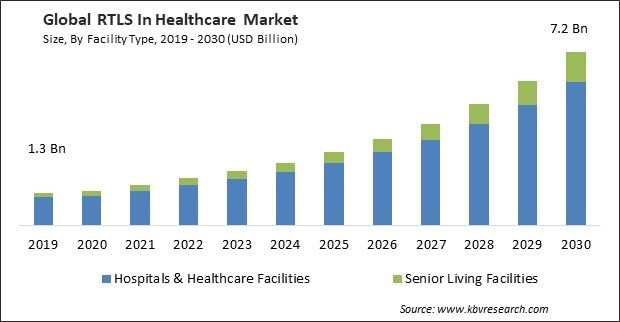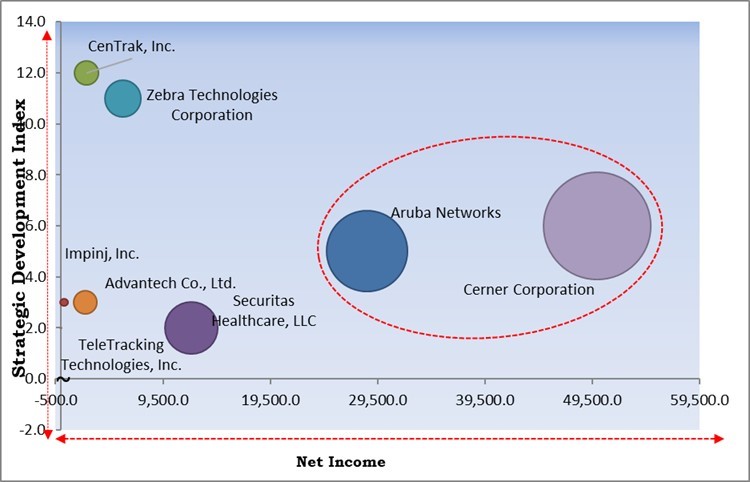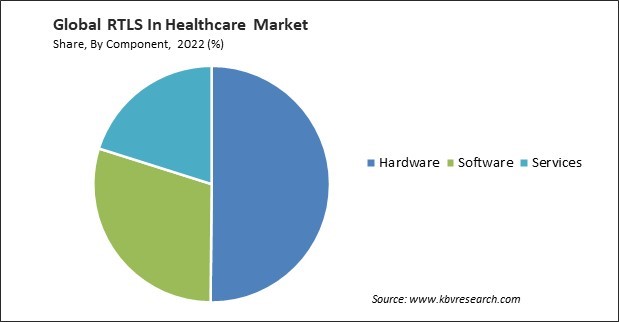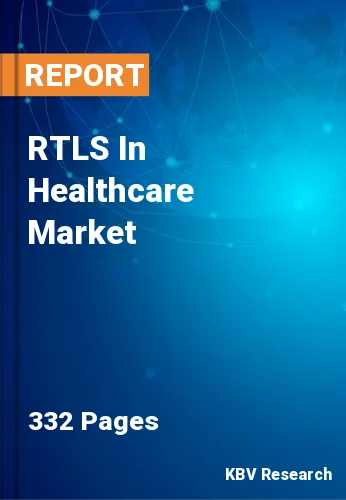The Global RTLS In Healthcare Market size is expected to reach $7.2 billion by 2030, rising at a market growth of 18.1% CAGR during the forecast period.
Efficient inventory management is crucial in healthcare to ensure the availability of essential supplies and minimize wastage. RTLS technology helps healthcare facilities manage ideal stock levels and lower the risk of stockouts. Thus, the supply chain management and automation segment captured $845.4 million revenue in the market in 2022. Supply chain automation and RTLS solutions help streamline the procurement and replenishment processes. Automated alerts and notifications for low stock levels trigger timely reordering, reducing the administrative burden and ensuring supplies are always available when needed. Owing to these factors, the supply chain management and automation segment will witness an increased demand in the future.

The major strategies followed by the market participants are Partnerships as the key developmental strategy to keep pace with the changing demands of end users. For instance, in September, 2023, Zebra Technologies Corporation came into a partnership with Minnesota Vikings. Zebra is utilizing its top-notch RFID tracking technology to gather player and ball data during the Vikings' practice sessions. Moreover, In August, 2021, CenTrak, Inc. integrated with Cisco DNA Spaces, a modern indoor location, and the IoT Services platform, utilizing Wi-Fi for data analytics. This integration enhanced user flexibility through multi-mode devices on Cisco Wi-Fi.
Based on the Analysis presented in the KBV Cardinal matrix; Cerner Corporation and Aruba Networks are the forerunners in the Market. In November, 2022, Aruba Networks collaborated with Lookout, Inc., the cloud security endpoint company, to integrate the HPE Aruba Edge Connect Enterprise SD-WAN platform with Lookout's security service edge platform. This collaboration has created a comprehensive secure access service edge architecture, zero-trust network access, cloud access security brokers, and data loss protection for customers.

The emphasis on enhancing patient care and safety incentivizes healthcare facilities to adopt RTLS technology. A key factor in adopting RTLS is the diverse range of healthcare settings where it can be applied. The focus on patient safety encourages a wider variety of healthcare facilities to consider RTLS technology. This expansion of the potential customer base further stimulates market growth, encompassing large hospitals and smaller clinics, assisted living facilities, and mental health institutions. Furthermore, as healthcare facilities implement RTLS solutions to enhance patient care and safety, they often experience a positive return on investment. Reducing adverse events, improved patient satisfaction, and efficient resource allocation contribute to cost savings and increased revenue. These factors will drive the expansion of the market in the coming years.
When healthcare facilities implement RTLS technology to manage their assets efficiently, they experience tangible cost savings. These cost savings can be significant, as they encompass reduced equipment loss, minimized equipment rentals or purchases, and lower maintenance costs. This positive impact on the bottom line reinforces the value of RTLS systems, encouraging healthcare institutions to invest further in these solutions. Moreover, the ability to showcase tangible cost savings and better resource utilization is a compelling selling point. Healthcare institutions are more likely to choose RTLS vendors that can demonstrate how their solutions lead to cost efficiencies. Owing to these factors, there will be increased demand for the market.
The substantial upfront costs of purchasing RTLS hardware, software, and infrastructure setup can be prohibitive for small organizations. As a result, smaller facilities may delay RTLS adoption or forgo it altogether. Additionally, economic factors, such as budget constraints, fluctuations in healthcare funding, and cost containment efforts, can lead healthcare facilities to prioritize other essential investments over RTLS technology. These factors are expected to limit the demand for RTLS adoption in healthcare in the coming years.
Based on facility type, the market is segmented into hospitals & healthcare facilities and senior living facilities. In 2022, the senior living facilities segment garnered a significant revenue share in the market. The aging population is a global phenomenon, and the demand for senior living facilities is rising. As the elderly population grows, the need for advanced healthcare technologies like RTLS becomes more apparent. RTLS solutions help these facilities better address the unique healthcare and safety needs of older residents. Therefore, the demand in the segment will rise in the future.
Based on component, the market is segmented into hardware, software, and services. In 2022, the services segment garnered a significant revenue share in the market. RTLS technology is intricate, involving a combination of hardware and software components. Implementing these systems in healthcare settings requires expertise and precision. Service providers offer implementation services, ensuring that RTLS systems are installed correctly, configured to the specific needs of the healthcare facility, and fully functional. They help overcome the complexity of installation, which is a significant barrier to adoption for many healthcare organizations. As a result, there will be increased demand in the services segment.

On the basis of technology, the market is divided into RFID, Wi-fi, UWB, BLE, and others. In 2022, the UWB segment witnessed a substantial revenue share in the market. UWB technology is renowned for its exceptional precision and accuracy in tracking assets, patients, and staff within healthcare facilities. This level of precision is particularly crucial in healthcare, where even small deviations in location data can have significant consequences. Hospitals and healthcare facilities often deal with valuable and critical assets, from medical equipment to pharmaceuticals. UWB-based RTLS systems offer the ability to track the exact location of these assets, leading to improved asset utilization, reduced losses, and streamlined workflows. These factors will help in the expansion of this segment.
On the basis of application, the market is segmented into inventory/asset tracking & management, personnel locating & monitoring, access control & security, environmental monitoring, supply chain management & automation, and others. In 2022, the personnel locating and monitoring segment witnessed a substantial revenue share in the market. The ability to track and monitor healthcare personnel, such as nurses and doctors, in real time contributes to better patient safety and care quality. With personnel locating and monitoring systems in place, healthcare providers can respond more quickly to patient needs, reducing response times during emergencies, and ensuring patients receive timely care. These factors are expected to boost the demand in the segment in the upcoming years.
| Report Attribute | Details |
|---|---|
| Market size value in 2022 | USD 1.9 Billion |
| Market size forecast in 2030 | USD 7.2 Billion |
| Base Year | 2022 |
| Historical Period | 2019 to 2021 |
| Forecast Period | 2023 to 2030 |
| Revenue Growth Rate | CAGR of 18.1% from 2023 to 2030 |
| Number of Pages | 332 |
| Number of Table | 483 |
| Report coverage | Market Trends, Revenue Estimation and Forecast, Segmentation Analysis, Regional and Country Breakdown, Competitive Landscape, Companies Strategic Developments, Company Profiling |
| Segments covered | Facility Type, Component, Technology, Application, Region |
| Country scope | US, Canada, Mexico, Germany, UK, France, Russia, Spain, Italy, China, Japan, India, South Korea, Singapore, Malaysia, Brazil, Argentina, UAE, Saudi Arabia, South Africa, Nigeria |
| Growth Drivers |
|
| Restraints |
|
By region, the market is segmented into North America, Europe, Asia Pacific, and LAMEA. The North America segment procured the highest revenue share in the market in 2022. North America, particularly the United States and Canada, boasts a well-established and mature healthcare infrastructure. This infrastructure includes a high concentration of hospitals, clinics, long-term care facilities, and medical research centers. To enhance patient care, optimize resource allocation, and boost operational effectiveness, these healthcare settings have been at the forefront of implementing cutting-edge technology, such as RTLS. Owing to these factors, the North America segment will expand rapidly in the coming years.
Free Valuable Insights: Global RTLS In Healthcare Market size to reach USD 7.2 Billion by 2030
The market research report covers the analysis of key stake holders of the market. Key companies profiled in the report include Securitas Healthcare, LLC, Zebra Technologies Corporation, Aruba Networks, Impinj, Inc., Savi Technology, Inc., Advantech Co., Ltd., Cerner Corporation, TeleTracking Technologies, Inc., CenTrak, Inc. and Ubisense Ltd.
By Facility Type
By Component
By Technology
By Application
By Geography
The Market size is projected to reach USD 7.2 billion by 2030.
Increasing demand for patient care and safety are driving the Market in coming years, however, High initial cost of implementation in the adoption of RTLS technology restraints the growth of the Market.
Securitas Healthcare, LLC, Zebra Technologies Corporation, Aruba Networks, Impinj, Inc., Savi Technology, Inc., Advantech Co., Ltd., Cerner Corporation, TeleTracking Technologies, Inc., CenTrak, Inc. and Ubisense Ltd.
The expected CAGR of this Market is 18.1% from 2023 to 2030.
The Hospitals & Healthcare Facilities segment is registering maximum revenue in the Market by Facility Type in 2022; thereby, achieving a market value of $6.0 billion by 2030.
The North America region dominated the Market by Region in 2022 and would continue to be a dominant market till 2030; thereby, achieving a market value of $2.9 billion by 2030.
Our team of dedicated experts can provide you with attractive expansion opportunities for your business.

